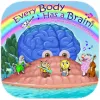Take a look inside 5 images
Every Body Has a Brain
Pros: Kids learn the vocabulary and functionality for each brain quadrant.
Cons: The tutorials could be more robust.
Bottom Line: Every Body Has a Brain makes brain science fun and accessible for young kids.
Teachers can use this simple tool to introduce brain awareness. Brain function is matched to region, and kids can learn the names of each and how they work together so that people can perform complex activities like dancing. Kids also get a peek at the differences between human and animal brains. Tutorials could be more robust, but the mini-games reinforce core learning concepts by having kids exercise different parts of their own brains via guided activities.
Every Body Has a Brain is an excellent resource for teaching kids aged 4-6 about the brain. It tackles the scientific subject with songs, animations, and friendly characters to create an inviting learning environment.
Using the mouse, kids explore a map of a brain and visit its four sections. In each, players meet friendly characters who provide information on how that part of the brain functions.
Every Body Has a Brain makes brain science understandable and alluring. Highly interactive and simple games fold in explanations of brain functions. Short, narrated texts partner with animated visuals, songs, and mini-games of several difficulty levels that encourage kids to learn by doing. For example, in one mini-game in the cerebral cortex -- the part of the brain associated with creative thinking -- players compose songs.
Mini-games are fully integrated into the experience. In each one, players use a specific part of the brain they've just learned about to perform tasks such as sorting items into boxes or creating simple melodies.











